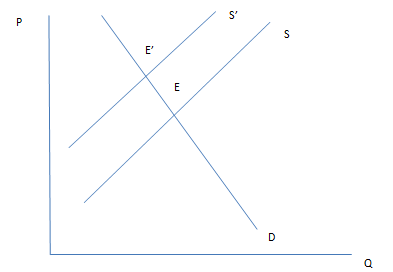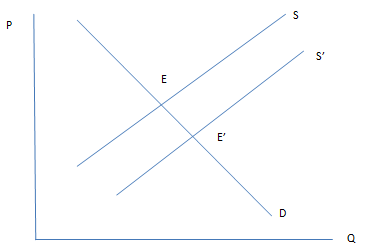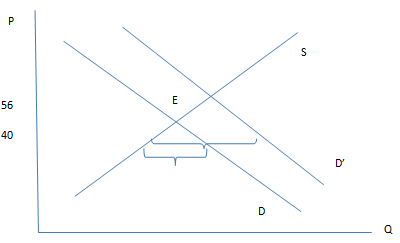Question:
Read the following excerpts from the article "Fruit, veg costs surge' by Todd, Dagwell, published in the Herald on January 25th 2011 and answer questions below:
Fruit, veg costs surge
Popular salads and fresh fruit juices are being scratched off menus as small business owners struggle with the rising cost of fruit and vegetables caused by the Queensland flood crisis. Sumo Salad Charlestown Square and Westfield Kotara owner Paul Phelan said he had been forced to substitute ingredients in some popular salads because of supply problems. He said cos lettuce and pumpkin were extremely difficult to find, and the available produce was terrible quality and expensive. "Pumpkin has tripled from $1.50 to $6 a kilo and the quality is really bad," Mr Phelan said.
Thurst Burst Marketown owner Neville Winter said finding quality fruit at an affordable price had been the biggest problem since the flood crisis began. Pineapple and oranges, two of the most popular ingredients in fresh fruit juices, had doubled in price. "Pineapple use to be $28 a box and the other day it was $56 a box, while oranges have doubled," Mr Winter said. "All other boxes of fruit have gone up by at least $10 a box." A spokesman for Boost Juice Charlestown said the shop was considering buying a large amount of produce and freezing it before the supply situation became any worse. All three businesses expect the problem to worsen in coming months.
Assume that the Australian government wishes to keep fruit and vegetable prices from rising to a socially unacceptable level. There are two options being considered: lift the import ban or impose a price ceiling.
You are expected to write an essay exploring the major issues raised in the article. In particular, you need to address the following issues:
- Use the demand and supply model to show the likely short-term impact of the flood on the price and quantity of fruit and vegetables in Australia.
- a) If a technological breakthrough ensures imported pumpkins are as good as domestic qualities and are thus allowed to be imported into Australia, use the demand and supply model to explain the short-term impact on the pumpkin market.
b) However, if consumers are uncertain regarding the quality of imported pumpkins, use the demand and supply analysis to explain the impact on the pumpkin soup market in the restaurant industry.
- Referring to the determinants of price elasticity of demand as they apply to pineapples analyze the likely impact on the market if the government imposes a retail price ceiling of $40 a box on pineapples. Specify any assumptions you have made.
Summary:
The assignment is about how the concepts of demand and supply interact and arrive at equilibrium prices of perishables such as fruits and vegetables. The differences in supply of and demand for fruits and vegetables are studied on graphs. The points where supply and demand curves intersect is generally taken as the price of the product, in this case, fruits and vegetables. Fruits and vegetables are very much susceptible to price changes due to their volatile supply.
Contents:
Introduction
Lifting the import ban
Price ceiling
Answer:
Introduction:
The balance between demand and supply depends upon a variety of factors. One of the most important factors among these is the continuity of supply. Any external shock which disrupts supply will lead a dismantling of the existing equilibrium and the prices are bound to fluctuate. As in the case of Australia, floods have destroyed the vegetable and fruit farming and hence, the supply of fruits, vegetables and consequently, fruit juice has been hindered.

The graph above depicts what happened to the fruits and vegetables market. Due to flood, the farming of fruits and vegetables was severely affected. This, in turn, led to a significant fall in the supply of these commodities. Therefore, while the demand at each price level was constant, the supply fell at each corresponding price level. This led to an upward shift of the supply curve from S to S'. The market, which was at equilibrium at E, is now in disequilibrium. At the initial equilibrium point a situation of excess demand is created. Now, the "invisible hand" comes into play to ensure the equilibrium. Since there is scarcity, the reservation prices of the consumers play an ever important role in the market. The exact mechanism is that people who have their reservation prices above the price in the market get the good. This keeps on happening and results into rationing out mechanism, under which, people who can pay higher prices get the commodity. Therefore, the price of fruits and vegetables increased. The economy moves towards point E', where the price level is higher than before and the equilibrium quantity is lower than before. Here, there is another very important factor which determines the quantum of increase in the prices: the elasticity of demand for the good. We all know that fruits and vegetables are needs of human being and not wants. Therefore, the demand for these goods is relatively inelastic demand. These commodities rarely have any substitutes and constitute a part of basic necessities; and hence, the demand will not go down much even when prices increase. Therefore, a scarcity of goods, coupled with the inelastic demand, leads to a rather steep increase in the prices. This is supported by the article as it says that prices of few commodities increased as much as two times.
This scarcity of these commodities is the main reason why the prices are high and even if someone tries to buy them at higher prices, quality is always a concern. In order to address this supply shortage, there can be two possible measures which be used. One involves the lifting of imports ban and the other involves a ceiling on the prices. We will explore both the measures in a little detail below. As we will see, appealing as these measures might seem to be, they may not really be the solution to the problem.
Lifting the import ban
Suppose there is a technological advancement and the quality of the imported fruits and vegetables is equivalent to the domestic breeds' quality. Prompted by this, assume that the government lifts the imports ban to counter the supply shortage. This means that at existing price level there will be an increase in the quantity being supplied. This will lead to a matching of demand and supply, as the demand remains roughly the same, irrespective of supply. In the graph below, assuming that the initial equilibrium was at E, and the initial supply curve was S, there will be a shift in the supply curve from S to S'. Now due to the increased supply and consequent shift of the supply curve, there will be a new equilibrium at E' (earlier the equilibrium was at point E). At the new equilibrium while prices go down, there will also be an increase in the equilibrium quantity. This scenario depicts that the problem of supply shortage has been sorted out efficiently.

However, the sorting out of this problem is not easy as it seems and the lifting of import ban might actually lead to further problems. A major assumption under this analysis is that the consumers are confident that the quality of the imported product is as good as that of the domestic product. Suppose this assumption is violated. What are the implications? First of all, the supply curve will shift to the right as before. However, now a situation of excess supply might arise. This will happen because of the reason that even though the commodities are available in the market, people might not wish to compromise on their taste. This, in turn, will lead to no or just marginal increase in the demand. Therefore, the market will not be able to reach equilibrium and there will be wastage of the imported product.
Price Ceiling
As the article mentions, the price of pineapples increase from $28 to $56, which is a twofold increase. Also, the price of oranges doubled and the price of most of the fruits increased in sizeable amount. Therefore, the prices of most of the fruits have increased over the period of time. In determining the elasticity of demand of some commodity, the prices of substitutes play an important role. For example, if the price of a good rises, while that of the substitute does not rise, there will be a shift in demand towards the substitute good. This will mean that there will be a higher fall in demand of the good for a given increase in the price compared to the situation when the price of the substitute had also risen. Therefore, price of substitutes play an important role in determining the elasticity- in the first case we have higher elasticity than in the second case.
Now, suppose a price ceiling of $40 is imposed on the price of pineapples. Also, the equilibrium in the market exists at E, at which price is $56.

Due to the ceiling, the supply of pineapples will fall. As we see in the graph, it will be lower than the initial level and hence lead to an even worse supply shortage. As the prices of other fruits, the substitutes, have also increased, the demand will shift to pineapples. Therefore, the demand curve of pineapples will shift to right- from D to D'-, as at each price level there is higher demand. Therefore, the situation of excess demand or supply shortage will further deteriorate. However, in the markets for substitutes, the demand pressure will ease down. The respective demand curves of the substitutes will shift down, which will lead to a fall in prices. Even this will be very short term phenomena, as the consumers will again get back to the substitutes market when they realize that prices in those markets have fallen down.